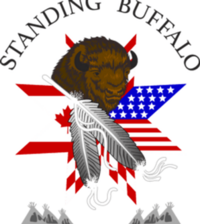Standing Buffalo Dakota Nation facts for kids
 |
|
| People | Dakota |
|---|---|
| Headquarters | Fort Qu'Appelle |
| Province | Saskatchewan |
| Land | |
| Reserve(s) | |
| Land area | 22.461 km2 |
| Population (2021) | |
| On reserve | 488 |
| Off reserve | 820 |
| Total population | 1308 |
| Government | |
| Chief | Roberta Soo-Oyewaste |
| Tribal Council | |
| File Hills Qu'Appelle Tribal Council | |
| Website | |
| standingbuffalodakotanation.com | |
The Standing Buffalo Dakota Nation (Dakota: Tataƞka Najiƞ Dakóta Oyáte) is a Dakota First Nations community located in southern Saskatchewan, Canada. This group of people manages their own affairs and lives on a special area of land called a reserve.
History of the Standing Buffalo Dakota Nation
The Standing Buffalo Dakota Nation is named after a very important leader, Chief Standing Buffalo. His Dakota name was Tatankanaje or Tataƞka Najiƞ. He became the chief in 1871, taking over from his father. This means he was a hereditary chief, a leader whose position is passed down through their family.
Early Settlement and Reserve Creation
Chief Standing Buffalo's people were given permission to farm land north of the Qu'Appelle Lakes. This was an important step for their community. In 1881, a special area of land was officially set aside for them. This land is known as their reserve.
At first, each family on the reserve was given 80 acres of land to farm. This was much less than the usual 640 acres given to other groups. Even with less land, the Standing Buffalo Dakota Nation worked hard and became very successful at farming. By 1901, all the families were able to support themselves through their farming efforts.
Challenges and Changes Over Time
However, in 1907, the community faced a big challenge. The government took back some important hay land that the band had been using. This land was crucial for feeding their animals and for their farming success. Losing this land greatly affected their ability to farm and earn a living.
The Standing Buffalo Dakota Nation asked for more land to make up for what they lost. They kept asking for many years, but their requests were not fully heard until 1956. This shows how important land was for their community and how they worked to get back what they needed to thrive.

